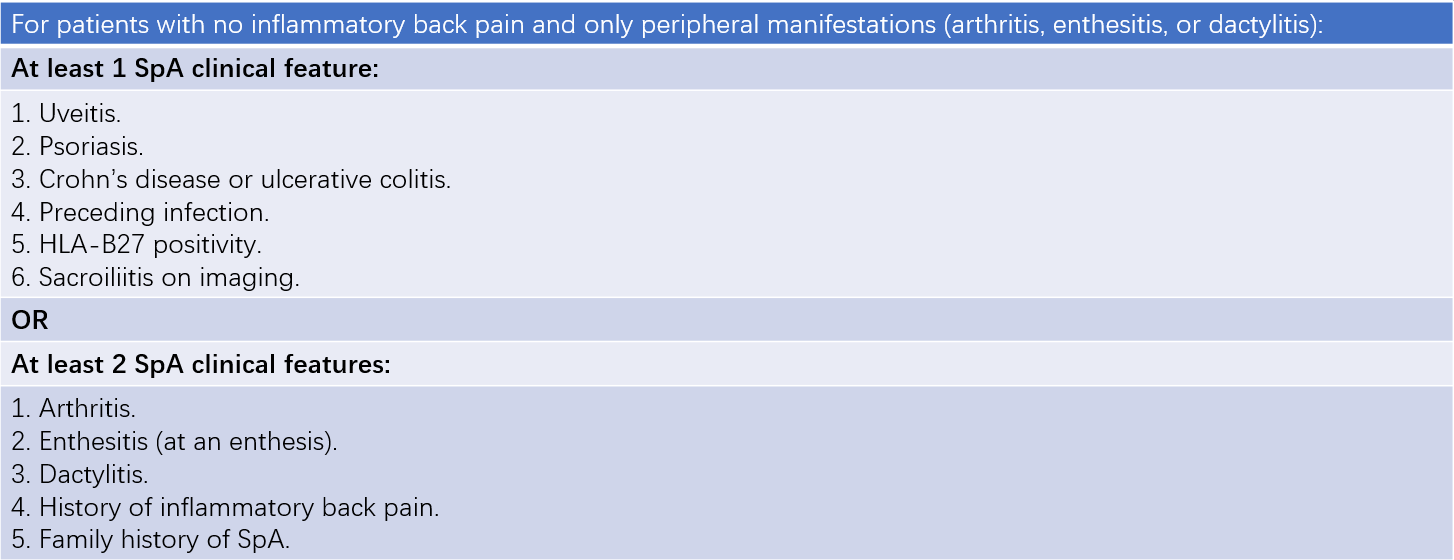Spondyloarthritis (SpA), previously referred to as seronegative spondyloarthropathy or spondyloarthropathy, represents a group of chronic inflammatory diseases primarily affecting the spine and/or peripheral joints. It may also involve additional clinical manifestations and systemic complications such as enthesitis, dactylitis, anterior uveitis, and ascending aortitis. This group of diseases includes ankylosing spondylitis (AS), psoriatic arthritis (PsA), reactive arthritis (ReA), inflammatory bowel disease-associated arthritis (IBDA), and juvenile-onset spondyloarthritis.
Epidemiological studies report the prevalence of SpA to range between 0.9% and 1.7%. Although different subtypes of SpA exist, they share common clinical and immunogenetic characteristics, which include:
- Predominantly axial joint involvement, presenting as inflammatory back pain, with imaging studies often revealing varying degrees of sacroiliitis.
- Peripheral arthritis that usually affects the large joints of the lower extremities and is often asymmetric.
- Frequent occurrence of dactylitis and enthesitis.
- A strong association with HLA-B27, with a familial clustering tendency.
- Negative rheumatoid factor (RF) tests.
The Assessment of SpondyloArthritis International Society (ASAS) proposed classification criteria in 2009 and 2011 for axial SpA and peripheral SpA. Axial SpA is further subdivided into ankylosing spondylitis (AS) and non-radiographic axial spondyloarthritis (nr-axSpA).

Table 1 ASAS classification criteria for axial spondyloarthritis
Notes:
Sacroiliitis on imaging (via MRI or X-ray): Satisfying condition (1) or (2).
(1), MRI indicating active (acute) inflammation of the sacroiliac joints, such as distinct bone marrow edema or osteitis, strongly suggesting sacroiliitis associated with SpA.
(2), X-ray showing bilateral sacroiliitis graded 2–4 or unilateral sacroiliitis graded 3–4 (according to the 1984 modified New York criteria for ankylosing spondylitis).
SpA clinical features include:
- Inflammatory back pain: At least 4 out of the following 5 criteria should be present:
- Onset before the age of 40.
- Insidious onset.
- Improvement with exercise.
- No improvement with rest.
- Pain at night, improving upon getting out of bed.
- Arthritis: Past or current acute synovitis diagnosed by a physician.
- Enthesitis (achilles tendon or plantar fascia): Past or current spontaneous pain or tenderness at the achilles tendon or plantar fascia insertion sites.
- Anterior uveitis: Anterior uveitis diagnosed by an ophthalmologist.
- Dactylitis: Past or current dactylitis diagnosed by a physician.
- Psoriasis: Past or current psoriasis diagnosed by a physician.
- Inflammatory bowel disease: Past or current diagnosis of Crohn’s disease or ulcerative colitis by a physician.
- Good response to NSAIDs: Recognized improvement in symptoms with non-steroidal anti-inflammatory drugs.
- Family history of SpA: A first- or second-degree family member with a history of ankylosing spondylitis, psoriasis, uveitis, reactive arthritis, or Crohn’s disease/ulcerative colitis.
- HLA-B27 positivity.
- Elevated C-reactive protein: Evidence of increased C-reactive protein levels.

Table 2 ASAS classification criteria for peripheral spondyloarthritis
Clinical Subtypes of SpA
Ankylosing Spondylitis
This is discussed in detail under the topic of ankylosing spondylitis.
Psoriatic Arthritis
Psoriatic arthritis is a chronic arthritis associated with psoriasis, with a peak onset age of approximately 40 years. Clinical features may include asymmetric joint swelling and pain, enthesitis, dactylitis, and inflammatory back pain. The severity of the joint symptoms does not necessarily correlate with the extent of skin lesions. Most patients develop joint symptoms after the onset of psoriasis; however, in some cases, arthritis may precede or coincide with the appearance of psoriasis. Around half of the patients experience joint erosions and destruction within two years of diagnosis, making it a disabling condition.
Inflammatory Bowel Disease-Associated Arthritis
This form of arthritis is associated with Crohn’s disease or ulcerative colitis and may present as peripheral arthritis, spondylitis, or sacroiliitis. Peripheral arthritis is often asymmetric and commonly involves the lower extremities. Approximately two-thirds of cases involve the knee joints. The joint symptoms often parallel the activity of the underlying bowel disease and typically resolve without causing joint deformity after bowel disease remission. Around 5%–10% of patients may develop a chronic disease course, with arthritis persisting for more than a year.
Reactive Arthritis
Reactive arthritis is a form of aseptic arthritis that follows an extra-articular infection. It is often preceded by gastrointestinal or urogenital infections 1–4 weeks before the onset of joint symptoms. The clinical presentation is characterized by asymmetric oligoarthritis (involving 2–4 joints), often affecting the lower extremities. Reactive arthritis is usually self-limiting, with symptoms resolving within 6–12 months of onset. However, approximately 15% of patients may develop chronic arthritis.
Juvenile-Onset Spondyloarthritis
Juvenile-onset spondyloarthritis is a subtype of juvenile idiopathic arthritis, with a mean age of diagnosis around 12 years and a male predominance. Early in the disease, it often presents as arthritis and enthesitis, typically as asymmetric oligoarthritis involving the large joints of the lower extremities. In the later stages of the disease, sacroiliac joint and spinal involvement may emerge. Extra-articular manifestations may include anterior uveitis, psoriasis, and inflammatory bowel disease.
To be continued